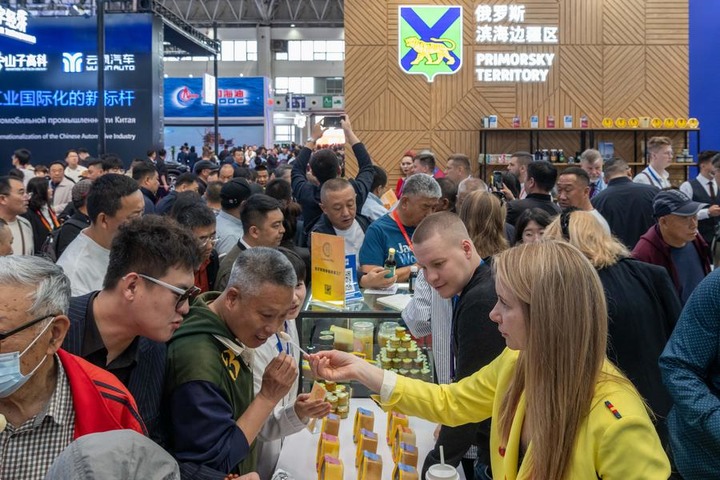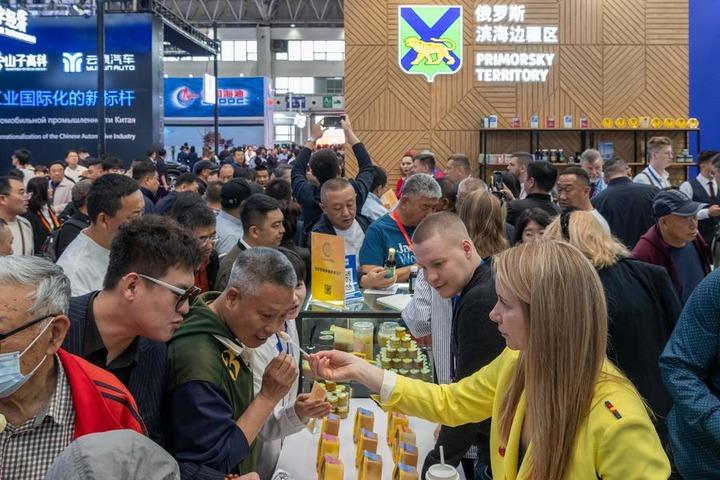
People visit the Russian pavilion during the 8th China-Russia Expo in Harbin, northeast China's Heilongjiang Province, May 18, 2024. (Xinhua/Xie Jianfei)
BEIJING, May 30 (Xinhua) -- The 8th China-Russia Expo was held in Harbin, northeastern China's Heilongjiang Province from May 16 to 21, 2024, attracting over 120 delegations from more than 40 countries and regions, and showcasing over 5,000 kinds of featured products from around the world.
Following the expo was the 6th Western China International Fair for Investment and Trade (WCIFIT) held in southwest China's Chongqing from May 23 to 26, which was attended by over 900 enterprises from 40 countries and regions as well as more than 20 provincial-level regions in China. The China (Shenzhen) International Cultural Industries Fair (ICIF) and the 7th Digital China Summit were also rolled out in May, in south China's Shenzhen and east China's Fuzhou, respectively.
The busy schedule of various exhibitions since the beginning of this year shows the significant recovery of China's exhibition industry, which is a symbol of China's robust economic growth.
-- Business opportunities for various companies
Recovery of China's exhibition industry has brought considerable business opportunities for foreign trade enterprises in the country.
"Thanks to the WCIFIT platform, we have further expanded our circle of friends," said Xu Xiaolong, a senior manager of the logistics center of Chongqing Changan Automobile Company Limited.
"For example, in Southeast Asia, we have established partnerships with 15 new local suppliers, achieving a localization rate of 44.9 percent, while our global supply chain is taking shape. In the first four months of this year, we have exported nearly 10,000 new energy vehicles," according to Xu.
In 2024, the exhibition industry will continue to play a vital role in economic recovery with expanding international influence, which will highlight a trend of professionalism and segmentation, and will facilitate China's efforts to go global, according to Wu Shengrong, head of the department of exhibition management at the China Council for the Promotion of International Trade (CCPIT).
Many foreign exhibitors regard such exhibitions as an opportunity to quickly establish their business presence in the Chinese market. At the China-Russia Expo, Maksim Sirotin, head of the export support center of Amur, Russia, brought products like honey, soybean oil and sausages to Chinese consumers.
-- Fruitful results in contracting
Major conventions and exhibitions are becoming increasingly important platforms for attracting foreign investment to localities.
It is reported that at the 6th WCIFIT, contracts have been signed on 12 foreign-funded projects with a total amount up to 26.7 billion yuan, involving 12 countries and regions such as Singapore and Germany.
The upcoming Expo Central China 2024 is expected to trigger another round of foreign investment in central China. The event organizers will invite Global Fortune 500 companies, multinational corporations, industrial leaders, as well as renowned chambers of commerce and business associations at home and abroad.
Meanwhile, foreign chambers of commerce, associations and investment promotional organizations are encouraged to attend the expo together with their members and branches.
"The active participation of multinational corporations highlights expectations for the rise of central China and the immense opportunities it will bring," said Li Zhengchun, director of the Investment Administration Division of the Department of Commerce of Hunan Province.
What's more, central China's Hunan province has been redoubling efforts to develop national key advanced manufacturing industries, and build itself into a pacesetter of technological innovation with core competitiveness, and into a pioneer of reform and opening-up in the inland area, said Li.
-- Comprehensive boost to the local economy
Besides promoting economic and trade exchanges, the revitalization of the exhibition industry has also given a strong boost to the local economy.
As a key driver of urban economy, the exhibition industry features a long industrial chain, high business correlations and a strong leading role. In addition to better match supply and demand, it injects momentum to relevant sectors such as accommodation and tourism.
The 7th Digital China Summit was held in Fuzhou during May 24-25, with the Fuzhou's Strait International Conference and Exhibition Center bustling with exhibitors and visitors for several days.
"My orders have almost doubled in these days thanks to this event," said a ride-hailing driver in Fuzhou, the capital city of east China's Fujian Province.
Fu Yifu, a senior researcher at the Star Atlas Institute of Finance, pointed out that exhibitions can facilitate the flow of logistics, passengers, capital, information and business across regions, and provide more opportunities for exchange for all stakeholders.
This can create new business opportunities, strengthen investment and trade ties, produce more economic benefits and inject vitality into the national economy, said Fu.
Meanwhile, such exhibitions will spur the development of relevant upstream and downstream sectors along the industrial chain such as transportation, tourism, catering, accommodation and advertising, according to Fu. (Edited by Yang Linlin with Xinhua Silk Road, linlinyanglyn@163.com)




 A single purchase
A single purchase









